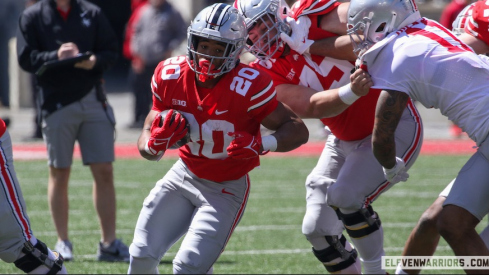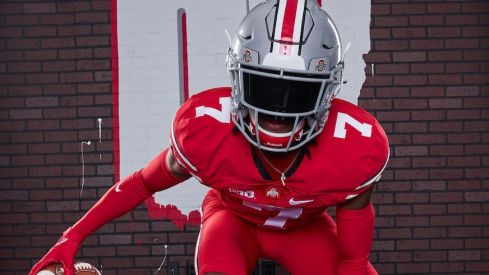
As the old adage goes, knowledge is power. Once the Ohio State coaching staff knew that Denard Robinson would not, or could not, throw, the Buckeyes had little difficulty stopping the Michigan offense.
In the second half, the Wolverines did not cross the 50-yard line. Indeed, Michigan's 21 first-half points belie that Ohio State's defense largely controlled the action for most of the game. Those points resulted from: 1) two explosive plays that accounted for nearly half of the Wolverine total yardage and 2) a Buckeye muffed punt and roughing the passer penalty.
But the Buckeye defense was particularly effective once they fully concentrated on preventing Denard Robinson from gaining the edge with aggressive cover 4 safety play. Once Michigan was unable to run the football with their most explosive playmaker they did not have any fallback method.
The Ohio State defense therefore controlled the second half, overcoming the offense's failure to punch the football in the end zone and securing a victory.
Two Defenses for Two Offenses
Michigan self-evidently employed two different schemes with Devin Gardner and Robinson. Putting aside the six plays where Robinson and Gardner took the field together, Michigan operated a pro-style based system with Gardner and a shotgun-spread framework with Robinson.
With Gardner, Michigan's primary M.O. was using under-center formations with 21 or 22 personnel to employ play-action max protection passing. Gardner would conduct a half roll off the run fake and Michigan would run two or three man route combinations, mostly to the wide field.
Against Michigan's under center offense, the Buckeyes primarily played cover 1, bringing CJ Barnett down in the 'box.'

Michigan had little hope of running the football under center and the Buckeyes therefore aggressively blitzed Gardner. For instance, as seen above, Zach Boren had an automatic blitz option based upon whether Michigan's backs stayed in to block. OSU also often used field blitzes to attack where the Wolverines wanted to roll Gardner to throw.
OSU's aggressive posture became more pronounced on third down. OSU often operated from their 30 front but brought far more pressure than they had heretofore shown from this look.
Like many inexperienced quarterbacks, Gardner held the football too long and was susceptible to rushed decisions under pressure. He also had limited options, given that the Michigan coaching staff apparently sought to simplify matters with two and three-man routes to one side of the field. He also does not have the strongest arm. By contrast, when he had time he was quite accurate. OSU thus continued to up the pressure as the game continued, particularly once they did not face a run threat.
Spread to Run and Only Run
By contrast, with Robinson on the field in shotgun OSU operated from cover 4 or quarter/quarter/half.

The Buckeyes' goal was to have their safeties attack the edge versus Michigan's base inverted veer.
Break-Break-Breakdowns
Unfortunately, the Buckeyes' solid game plan was overwhelmed by an old problem, that being allowing explosive plays. The first, Gardner's touchdown pass to Roy Roundtree, was a multi-faceted mental breakdown. The first problem was that OSU was in cover 2 versus Michigan's trips.

Cover 2 is not an ideal defense against this formation. Indeed, defenses will often check out of 2 once they see the three receiver side. But if you are going to run cover 2 against trips, the corner has to sink and the safety has to play the deep route. Here, Travis Howard instead jumps the flat route and CJ Barnett the intermediate, allowing Roundtree to come free.
Too Cute by Half
Michigan's second touchdown was enabled by a punt block play that perhaps looked better on paper than in practice. OSU sought to set up a punt block by throwing off Michigan's count as to how many rushers were in the box by having Corey Brown initially line up over the left gunner and then sprint back to field the punt. The problem is that it is difficult for anyone to sprint 45 yards only to turn around and field a punt.
Identifying Playmakers
But the Wolverine offense remained at its most dynamic based upon Robinson's run threat. Robinson was able to attack the edge largely off Michigan's favorite play, inverted veer. Here, once Michael Bennett misses a tackle, Robinson's gain is set up by Barnett first playing pass and then not maintaining contain.
Al Borges also did a nice job taking a page from Ohio State's playbook and running a fake veer that is simply a lead sweep. Note how Michigan used an unbalanced alignment with this package. But the Buckeye secondary did not adjust their numbers to the centerline, leaving both a corner and safety to the opposite side of a field without an eligible receiver.
Again note how the Buckeye safeties conservatively read for pass before attacking the run. The result of these breakdowns was that Michigan was able to gain a one-point halftime lead.
So You Literally are Not Going to Pass?
OSU's employment of cover 4 changed in the second half, and with it Michigan's ability to run the football with Robinson at quarterback. While the spread equalizes the offense's arithmetic it cannot change the fact that the defense will always have an unblocked defender who is the ball carrier's counterpart. Therefore a spread-to-run offense that does not pass is still going to be at a distinct disadvantage. Ohio State was able to use that reality to their advantage in the second half. The Buckeyes in theory ran the same cover 4 defense but in practice applied it in a very different manner. The Buckeye safeties sat at ten yards. As soon as Robinson moved away the backside safety shot the nearest gap.
The Buckeyes' frontside safety would then provide aggressive edge support as soon as run action came towards them. Above all else, the Buckeyes wanted to prevent Robinson from getting outside the defense's contain.
This strategy successfully coalesced on OSU's fourth-down stop of Robinson.
In the still below, note how both Barnett and Etienne Sabino maintain outside leverage on Robinson. This forced Robinson inside, allowing Ryan Shazier to display a textbook scrape inside Taylor Lewan to make the play. For a team that struggled this year with force and leverage, this play exemplified the improvements that the Buckeye defense made fundamentally.
Though Robinson admirably took responsibility for cutting a hole too far inside, it is unclear how he would have gotten farther outside. He would had to have gone backwards to try to get around Barnett, likely leading to the same result.

Now What?
The Buckeye stalling of Robinson getting outside largely stalled the Michigan offense. Once Robinson was forced inside, OSU could take advantage of the talent advantage their defensive line had relative to the Michigan front. This was more pronounced when the Wolverines ran from under center, which was effectively a gift to the Buckeye defense.
Michigan was thus forced to become one-dimensional, allowing the OSU coaching staff to mix and match blitzes and zone coverages, leading to Gardner's fourth-quarter interception.
A Season in Microcosm
The Buckeye defensive performance was thus actually more impressive then the baseline stats showed. As Seth at MGoBlog pointed out, the Wolverines' yards per attempt-adjusted, which simply limits maximum gains or losses to 20 yards to prevent outliers from skewing the stat, was 3.0 yards per attempt. Without Robinson, this figure drops to 1.2 yards per try, demonstrating that once the Buckeyes slowed Robinson, Michigan had few answers.
The Buckeyes' last game was in some ways a microcosm of their season. The offense carried OSU early, as the Buckeye defense struggled with allowing big plays. But in the end, the OSU defense was the key to the win, as it rendered the Wolverine offense a non-entity.
And so it was with the defense this fall. As with the offense, I will provide a more comprehensive breakdown of the defense's development in the coming months. But in short, the defensive coaching staff was cobbled together with coaches who by and large had not worked together. And they struggled to find an identity. But in the season's second half the coaches seemed to find their schematic stride.
On first and second down, the Buckeyes largely played single high safety looks against under center teams, with cover-4 based schemes against spread looks. Then on third down the Buckeyes alternated between blitz and zone coverage looks. This turned out to be an effective compromise between the disparate coaching backgrounds and allowed the Buckeyes to play more aggressively than they had in years past, without abandoning the fundamental soundness that has defined the unit.
Of course, it is no coincidence that this was also the time when Zach Boren moved to defense, solidifying the defense's leadership, toughness and fundamental play. It was also when Barnett and Nate Williams returned to health, and when Shazier and Bryant developed into more sound players. Though the defense was never perfect—as witnessed against Michigan—and still had holes that were band-aided over and will again need to be filled next year, the improvement of both the defensive coaches and fundamentals are a positive sign moving forward.
The 2012 Buckeyes were only able to go undefeated, though, because every single unit—offensive, defense, and special teams—stepped up at different times to carry other areas that were struggling. And that ability to be well rounded and play as a team is what this group should be remembered for.

